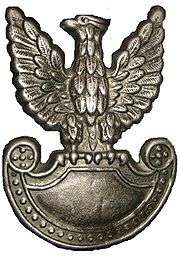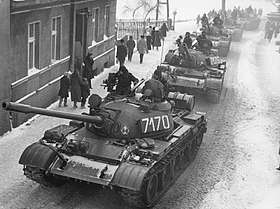Polish People's Army
The Polish People's Army (Ludowe Wojsko Polskie pronounced [luˈdɔvɛ ˈvɔi̯skɔ ˈpɔlskʲɛ], LWP)[1] constituted the second formation of the Polish Armed Forces in the East in 1943–1945, and in 1945–1989 the armed forces of the Polish communist state (from 1952, the Polish People's Republic), ruled by the Polish Workers' Party and then the Polish United Workers' Party. The communist-led Polish armed forces, allowed and facilitated by Joseph Stalin, were the result of efforts made in the early 1940s in the Soviet Union by Wanda Wasilewska and Zygmunt Berling.
| Polish People's Army | |
|---|---|
| Ludowe Wojsko Polskie | |
 Emblem worn by LWP soldiers; the "Piast eagle" without the crown | |
| Motto | God, Honor, Fatherland (Bóg, Honor, Ojczyzna) |
| Founded | May 1943 |
| Disbanded | 30 December 1989 |
| Service branches | Polish Land Forces Polish Air Force Polish Navy |
| Industry | |
| Foreign suppliers | |
| Annual exports | |
| Related articles | |
| History | List of wars involving Poland Timeline of the Polish Army |
The official name of those formations were: Armia Polska w ZSRR (Polish Army in the USSR) from 1943–1944, Wojsko Polskie (Polish Troops) and Siły Zbrojne Rzeczpospolitej Polskiej (Armed Forces of the Republic of Poland) from 1944–1952 and from 1952 Siły Zbrojne Polskiej Rzeczypospolitej Ludowej (Armed Forces of the Polish People's Republic).
World War II
.jpg)

What became the LWP was formed during World War II, in May 1943, as the 1st Tadeusz Kościuszko Infantry Division, which developed into the First Polish Army, unofficially known as Berling's Army. Because of the shortage of Polish officers and policies of the Soviet Union, in March 1945 Soviet Red Army officers accounted for nearly 52% of the officer corps (15,492 out of 29,372). Around 4,600 of them remained in the LWP by July 1946.[2]
It was not the only Polish formation that fought on the Allied side, nor the first one formed in the East. The earlier Polish force formed in the Soviet Union, known as Anders' Army, was loyal to the Polish government-in-exile and by that time had moved to Iran. The communist-led Polish forces soon grew beyond the 1st Division into two major commands – the First Polish Army (initially under Zygmunt Berling) and the Second Polish Army (commanded by Karol Świerczewski). The First Polish Army participated in the Vistula–Oder Offensive, the Battle of Kolberg and the final Battle of Berlin.[1]
Post-war history

After the war the Polish Army was reorganized into six (later seven) military districts. These were the Warsaw Military District, headquartered (HQ) in Warsaw, the Lublin Military District, HQ in Lublin, the Kraków Military District, HQ in Kraków, the Łódź Military District, HQ in Łódź, the Poznań Military District, HQ in Poznań, the Pomeranian Military District, HQ in Toruń, and the Silesian Military District, HQ in Katowice.
In the late 1940s and early 1950s, the Polish Army was under the command of Marshal of the Soviet Union, Marshal of Poland and Minister of Defense of Poland Konstantin Rokossovsky. It was increasingly integrated into Soviet military structures. This process was mitigated in the aftermath of the Polish October of 1956, when Władysław Gomułka formalized aspects of Poland's military relationship with the Soviet Union.[3]
References
- Popularna Encyklopedia Powszechna Wydawnictwa Fogra (2016). "Pierwsza Armia Wojska Polskiego". Encyklopedia WIEM. Cite journal requires
|journal=(help) - Kałużny, Ryszard (2007). "Oficerowie Armii Radzieckiej w wojskach lądowych w Polsce 1945-1956". Zeszyty Naukowe WSOWL (in Polish). AWL (2): 86–87. ISSN 1731-8157.
- Jerzy Eisler, Siedmiu wspaniałych poczet pierwszych sekretarzy KC PZPR [The Magnificent Seven: First Secretaries of KC PZPR], Wydawnictwo Czerwone i Czarne, Warszawa 2014, ISBN 978-83-7700-042-7, pp. 214–215
